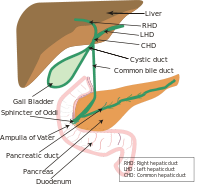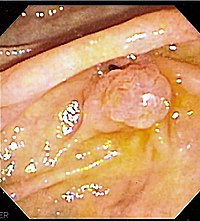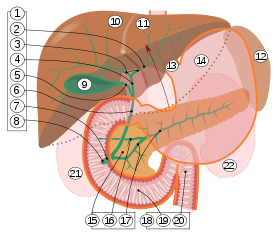Ampulla of Vater
| Ampulla of Vater | |
|---|---|
 A diagram of the biliary system. Note that the ampulla of Vater is behind the major duodenal papilla. | |
 The major duodenal papilla, seen on duodenoscopy at the time of ERCP. This is the protrusion of the ampulla of Vater into the duodenum. | |
| Details | |
| Identifiers | |
| Latin | ampulla hepatopancreatica, ampulla Vaterii |
| MeSH | D014670 |
| TA98 | A05.8.02.017 |
| TA2 | 3111 |
| FMA | 15076 |
| Anatomical terminology | |
The ampulla of Vater, hepatopancreatic ampulla or hepatopancreatic duct is the common duct that is usually formed by a union of the common bile duct and the pancreatic duct within the wall of the duodenum. This common duct usually features a dilation ("ampulla"). The common duct then opens medially into the descending part of the duodenum at the major duodenal papilla. The common duct usually measures 2-10mm in length.[1]
The ampulla of Vater is an important landmark halfway along the second part of the duodenum marking the transition from foregut to midgut.[citation needed]
Structure

2. Intrahepatic bile ducts
3. Left and right hepatic ducts
4. Common hepatic duct
5. Cystic duct
6. Common bile duct
7. Ampulla of Vater
8. Major duodenal papilla
9. Gallbladder
10–11. Right and left lobes of liver
12. Spleen
13. Esophagus
14. Stomach
15. Pancreas:
16. Accessory pancreatic duct
17. Pancreatic duct
18. Small intestine:
19. Duodenum
20. Jejunum
21–22. Right and left kidneys
The front border of the liver has been lifted up (brown arrow).[2]
Sphincters
Various smooth muscle sphincters regulate the flow of bile and pancreatic juice through the ampulla: the sphincter of the pancreatic duct, the sphincter of the bile duct, and the sphincter of Oddi.[3]
Variation
The common bile duct and pancreatic duct may sometimes unite outside the duodenal wall, creating an unusually long common duct. The two ducts may also drain into the duodenum separately, or may fuse yet retain their separate lumens separated by a septum.[1]
Clinical significance
Thomas' sign is the production of silver stools and can be indicative of cancer of the Ampulla of Vater. The silver-colored stool is a combination of the white stool of obstructive jaundice combined with black stool of melena or bleeding. It was first described in the British Medical Journal by Dr. H. Ogilvie in 1955.[4]
Etymology
The eponymic term "ampulla of Vater" is named after Abraham Vater (1684–1751),[5] a German anatomist who first published a description of it in 1723.[6]
Additional images
-
The pancreatic duct.
-
Carcinoma of Ampulla
Text is available under the CC BY-SA 4.0 license; additional terms may apply.
Images, videos and audio are available under their respective licenses.


